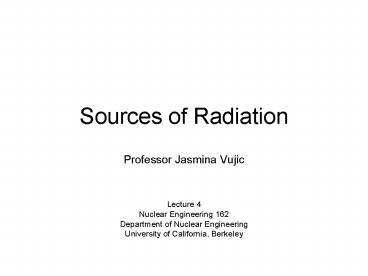Sources of Radiation - PowerPoint PPT Presentation
1 / 38
Title:
Sources of Radiation
Description:
Cosmic Ray Interactions in the Atmosphere. Natural Radioactive Sources within the Body ... Cosmic Ray Interactions in the Atmosphere. Cosmic Ray Interactions ... – PowerPoint PPT presentation
Number of Views:36
Avg rating:3.0/5.0
Title: Sources of Radiation
1
Sources of Radiation
- Professor Jasmina Vujic
- Lecture 4
- Nuclear Engineering 162
- Department of Nuclear Engineering
- University of California, Berkeley
2
SOURCES OF RADIATION
- NATURAL RADIATION SOURCES
- Radioactive Sources in the Ground
- Cosmic Ray Interactions in the Atmosphere
- Natural Radioactive Sources within the Body
- MAN-MADE RADIATION SOURCES
- Medical and Dental X-Ray Machines
- Industrial X-Ray Machines
- Accelerators
- Man-made Radioisotopes
- Fallout from Past Bomb Tests
- Nuclear Power Reactors
3
Radioactive Sources in the Ground
- Primordial Radionuclides 238U, 232Th and 235U
radioactive decay chains 40K and 87Rb 22Na - Cosmogenic radionuclides 14C, tritium (3H), 7Be,
and 22Na
4
(No Transcript)
5
(No Transcript)
6
(No Transcript)
7
(No Transcript)
8
Cosmic Ray Interactions in the Atmosphere
9
Cosmic Ray Interactions in the Atmosphere
10
- Radon as a source of internal exposure 238U
chain, 226Ra decays into 222Rn. The significant
dose is from the decay products of radon
11
Natural Radioactive Sources within the Body
- Potassium-40 140 g of potassium in a man of 70
kg (i.e. 0.1 /µCi) - Carbon and hydrogen in the biosphere contain 14C
and 3H - Radon and its decay products
- 137Cs, 131I, 90Sr
12
The Contribution of Natural Radiation Sources
13
SOURCES OF X-RAYS
- Two principal methods for generating X-rays
- The rearrangement of atomic electron
configurations - "Characteristic X-Rays"
- The deflection of charged particles in the
vicinity of the atomic nucleus - "Continuous X-Rays or Bremsstrahlung
14
CHARACTERISTIC X-RAYS
- Characteristic X-rays are emitted from the atomic
shells, when electrons jump from the shells at
higher energy levels (with Iower binding energy)
to the vacancies in the shells at lower energy
levels (with higher binding energies). - The binding energy of the K-shell electron is the
largest in an atom (for example, it is 13.6eV for
H and up to 115keV for U) - The energy of the emitted X-ray is determined by
- where Em is the upper energy level and En is
the lower energy level.
15
CONTINUOUS X-RAYS
- In addition to loosing its kinetic energy in
collisions with the atomic electrons causing
ionization or excitation of the atoms along its
path, a charged particle (in our case an
electron) gives up its kinetic energy by a photon
emission as it is deflected (or accelerated) in
the electric field of nuclei. - The emitted EM radiation has a continuous energy
spectrum from 0 to Ek, where Ek is the kinetic
energy of a charged particle. - For Ek lt 100 keV, radiation is emitted at 900 to
the direction of the charged particle. For higher
Ek the direction of the emitted radiation shifts
toward the forward-peaked direction.
16
X-RAY MACHINES
- Made of a glass vacuum tube with two electrodes
cathode and anode - Cathode with tungsten wire (filament) is heated
and electrons are emitted - Electrons are accelerated by a large potential
difference (high voltage) - The focusing cup concentrates electrons into the
target oh the anode - After hitting the target, electrons are abruptly
brought to rest with the lost of their kinetic
energy - Only about 1 of electron kinetic energy is
emitted as EM radiation, 99 is lost in
electronic collisions and converted to heat
(anode must be cooled)
17
(No Transcript)
18
(No Transcript)
19
Medical and Dental X-Ray Machines
20
Medical and Dental X-Ray Machines
21
Fallout from Past Bomb Tests
22
Fallout from Past Bomb Tests
23
Fallout from Past Bomb Tests
24
Nuclear Power Reactors
25
Nuclear Power Reactors
26
Radionuclides used in Diagnostics and Therapy
27
(No Transcript)
28
Choice of Radioisotopes for Imaging
- The physical characteristics that are desirable
for nuclear medicine imaging include - A suitable physical half-life
- Decay via photon emission
- Photon energy high enough to penetrate the body
tissue with minimal tissue attenuation - Photon energy low enough for minimal thickness of
collimator speta - Absence of particulate emission
29
Important Nuclides of Biomedical Uses
30
Production of Radionuclides
- There are several ways by which radionuclides are
produced - Neutron capture (neutron activation)
- Nuclear fission
- Charged-particle bombardment
- Parent decay (radionuclide generator)
31
Radionuclides produced by neutron absorption
32
Radionuclides produced by nuclear fission
33
(No Transcript)
34
Radionuclides produced by charged particle
bombardment
35
(No Transcript)
36
Generator-produced radionuclides
37
(No Transcript)
38
(No Transcript)































